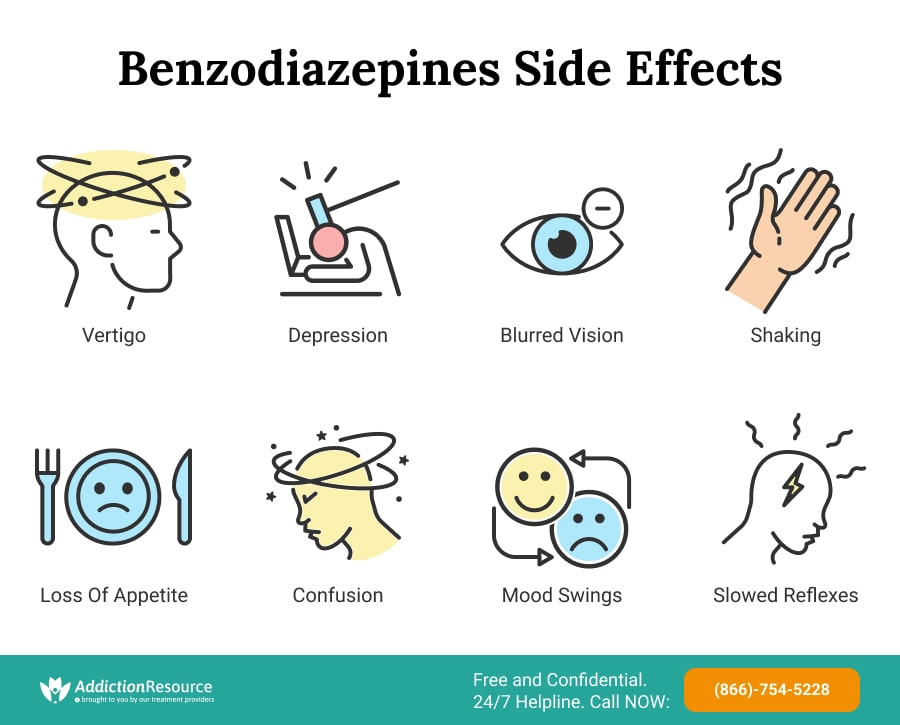Benzodiazepines, also known as benzos, are drugs that are mainly used to treat anxiety disorders, including panic and social anxiety disorders, and insomnia. Although there are different types of benzodiazepines, all of these are considered prescription medications. In 2019, around 52 million prescriptions of benzos were issued in the United States. Because of these statistics, it is necessary for patients using these drugs to understand what they can do to their bodies. Take note that the abuse of benzos is dangerous to the health as it does not only lead to addiction but also discomforting adverse reactions.
Table Of Contents:
In this article, information about the short-term and long-term benzodiazepines side effects, their dangers in pregnancy, and benzodiazepines contraindications will be provided.
More About Benzodiazepines:
Long- and Short-Term Benzodiazepines Side Effects
All medications have the potential to produce unwanted symptoms, but benzodiazepines side effects can be particularly troublesome. According to the Royal Australian College of General Practitioners, it is recommended to use benzodiazepine drugs in short-term treatment for anxiety, which is around 1 to 4 weeks only. This technique is done to reduce the risks of benzodiazepine withdrawal, dependence, and other cognitive problems. However, when patients misuse or abuse these drugs, the benzos side effects can become insufferable. In addition to the usual side effects of benzodiazepines associated with short-term treatment, there are long-term use benzodiazepines side effects that are even more devastating.
Short-Term Benzo Side Effects
Benzos are designed to act quickly and last for just a few hours, which means they essentially flood the system with medication. However, this period still depends on the route of administration and the type of benzo used. For example, the Midazolam drug, short-acting benzo for anxiety disorders and insomnia, when administered intranasally, could produce a rapid onset of action in 5-15 minutes and its effect may last for one hour. On the other hand, Diazepam, another long-acting benzo for anxiety disorders and insomnia, when administered orally, could produce an onset of action within 15-60 minutes and its effect may last for 12 hours.
As a result, one of the primary side effects of benzodiazepines is a hangover effect where the user feels drowsy and sluggish and might experience headaches and nausea. When taken in larger doses, benzo effects can become more common, and the longer the drug is taken, the more likely these symptoms are to develop.
Other short-term benzodiazepines side effects include the following:
- Lethargy
- Confusion
- Lack of coordination
- Vertigo
- Depression
- Blurry vision
- Memory issues
- Incoherent speech
- Shaking
- Bowel troubles
- Loss of appetite
- Shallow breathing
- Mood changes
- Slowed reflexes
Based on a study of a medical doctor from the UK, these benzodiazepines side effects are likely to occur with elderly patients and those populations with other health illnesses. In case any of these short-term benzos side effects appear, seek medical help to avoid other dangerous health events.

Long-Term Effects of Benzodiazepines
When benzos are used longer than recommended, there is the potential for long-term side effects to develop. The first ones a user is likely to experience are short-term side effects of benzodiazepines, but to a greater degree, physical and mental dependence on the drug can occur. From there, other effects do not become problematic but can last long after they have been stopped. Benzodiazepines effects in the long term will be discussed in this section.
Benzos and Sensory Changes
One of the long-term effects of benzodiazepines includes changes in sensory perceptions. According to the American Family Physician, from the sensory changes benzodiazepines effects give, sensory hypersensitivity is the most common. This is consistent with the study of psychologists from the University of Michigan. In their study, it was reported that the use of benzos promotes the enhancement of taste palatability. Moreover, based on the report of pharmacists from Massachusetts, it was stated that the use of benzos can cause tinnitus. This ear condition is one of the auditory hypersensitivities associated with hyperacusis or having a loudness perception.
Benzodiazepines and the Decline in Cognitive Function
If a patient takes a benzodiazepine drug for a long period or abuses it, long-term effects of benzodiazepines including the decline in cognitive function can be observed. According to a study published in the Archives of Internal Medicine, this cognitive dysfunction is common in the elderly. Aside from this, reduced learning ability and cognitive deterioration can also be considered benzodiazepines effects. Some of the mental health conditions associated with benzodiazepine use include dementia and Alzheimer’s Disease.
Benzodiazepines and Dementia
In one study published in the Journal of Clinical Neurology, it was reported that one of the long-term effects of benzodiazepines is dementia. Those who do not have the mental health condition may acquire it while those who are already suffering from it may experience worsening of the condition. Also, in the same study, it was reported that benzos with longer half-lives are those that highly increase the risk of dementia. These benzos with long half-lives include Chlordiazepoxide and Diazepam.
Benzos and Alzheimer’s Disease
Another mental health condition that can be acquired because of the long-term use of benzos is Alzheimer’s Disease. When one has this condition, a patient can experience memory problems and the inability to carry out simple tasks. According to the Harvard Medical School, taking a benzodiazepine drug for 3 to 6 months can increase the risk of developing Alzheimer’s Disease by 32%. Additionally, this risk can be increased by 84% when a patient takes a benzo drug for more than 6 months. Looking at this data, it is safe to say that the risk of developing cognitive dysfunction and other related problems depends on the length of use of the drug.
Benzodiazepines in Pregnancy
Also in 2019, around 11.3 million people in the United States were given benzodiazepine drug prescriptions. Because of these huge numbers, patients, especially pregnant ones should know if these drugs are safe for their and their baby’s health. According to the American College of Obstetricians and Gynecologists, most benzos belong to the pregnancy category D. This means that the benzos cause dangers and risks to fetal health.
With regards to breastfeeding, based on the report of medical doctors from Japan, the benzodiazepine concentration transferred into breast milk is relatively small and is said to be compatible with breastfeeding. However, this data is not the same for all benzodiazepine drugs. It was also reported that although Benzos are safe for pregnant women when used with caution, they are not safe for the fetus and during lactation because these drugs can cause lethargy, sedation, and weight loss in infants.
Indeed benzos are effective drugs in managing and treating anxiety disorders and even insomnia. However, patients using these medications should strictly follow the directions given to them by medical doctors.
Benzodiazepines Contraindications
Most drugs, including the over-the-counter ones, come with contraindications and warnings. These should be carefully noted because they can cause unwanted health events. With regards to the benzos, aside from pregnancy and lactation, based on the report of psychiatrists from the United States, benzodiazepines contraindications are the following:
- Patients who are hypersensitive to benzos
- Patients with narrow-angle glaucoma
- Those with respiratory depression: COPD, Respiratory failure
- Drug-dependent patients: Alcohol use disorder, illicit drug abuse, prescription medication abuse and dependence
Other benzodiazepines contraindications include those patients with myasthenia gravis. In a study published in The Journal of Neuropsychiatry and Clinical Neurosciences, it was reported myasthenia gravis patients who took benzos experienced worsening of myasthenic symptoms such as respiratory muscle weakness and distress. Furthermore, there are also benzodiazepine warnings. These should be noted to promote the safe use of the benzodiazepine drug class.
Some of the warnings FDA would like to include in all benzo drugs include:
- Abuse and misuse of benzos can lead to overdose and death
- Benzodiazepine drug interactions: opioid pain relievers, alcohol
- Physical dependence can occur when benzos are taken for a long period, even when prescribed
- Life-threatening benzodiazepine withdrawal
For these reasons, patients should learn that benzos cause serious risks and harm to their health when these drugs are abused. At the same time, medical doctors and other healthcare professionals, especially pharmacists are highly urged to provide medication counseling or guide to patients under benzo treatment.
Benzos and Alcohol
One of the uses of benzos is for the treatment of alcohol use disorder. In a clinical review of psychiatrists from India, it was stated that benzos are the gold standard for alcohol addiction and withdrawal. However, this does not mean that it is safe to drink while on the benzo treatment, and as much as possible, one should never mix benzos and alcohol to avoid health dangers.
As cited in The Journal of American Managed Care, aside from increasing the sedative effects of the substances and the risk of overdose, it was reported that mixing benzos and alcohol come with undesirable side effects including cardiovascular gastrointestinal, hepatic, kidney, and neurologic injury, as well as exacerbation of psychiatric conditions. Additionally, according to the Centers for Disease Control and Prevention, it was reported that in 2010, in benzos and alcohol interaction, alcohol accounts for 27.2% of benzodiazepine-related visits and 24.1% of benzodiazepine-related deaths in the United States.
Always Consult Your Doctor
When patients abuse or misuse these drugs, not only short-term benzos side effects can be experienced but also long-term ones. Aside from benzodiazepines overdose, dependence, withdrawal, and addiction, these drugs cause dangers to the sensory receptors and cognition of the users.
Furthermore, managing benzos side effects can be effectively done by a healthcare professional. In case patients experience these benzos side effects, especially overdose, it is highly advised to seek medical help as soon as possible. When patients become addicted to these drugs, remember that there is hope for everyone. Those suffering from benzodiazepine addiction may consider addiction treatment at rehabilitation centers. Healthcare professionals working here could provide a drug intervention, relapse prevention plan, and proper benzodiazepine detoxification to manage both addiction and withdrawal. During this time of the pandemic, there are online narcotics anonymous meetings that can help patients obtain a more successful and safer drug addiction recovery.
Hope Without Commitment
Find the best treatment options. Call our free and confidential helpline
Most private insurances accepted
Page Sources
- Guina, J., & Merrill, B. (2018). Benzodiazepines I: upping the care on downers: the evidence of risks, benefits and alternatives. Journal of clinical medicine, 7(2), 17.
- He, Q., Chen, X., Wu, T., Li, L., & Fei, X. (2019). Risk of dementia in long-term benzodiazepine users: evidence from a meta-analysis of observational studies. Journal of Clinical Neurology, 15(1), 9-19.
- Herings, R. M., Stricker, B. H. C., de Boer, A., Bakker, A., & Sturmans, F. (1995). Benzodiazepines and the risk of falling leading to femur fractures: dosage more important than elimination half-life. Archives of Internal Medicine, 155(16), 1801-1807.
- Hirschtritt, M. E., Palzes, V. A., Kline-Simon, A. H., Kroenke, K., Campbell, C. I., & Sterling, S. A. (2019). Benzodiazepine and unhealthy alcohol use among adult outpatients. The American journal of managed care, 25(12), e358.
- Iqbal, M. M., Sobhan, T., & Ryals, T. (2002). Effects of commonly used benzodiazepines on the fetus, the neonate, and the nursing infant. Psychiatric Services, 53(1), 39-49.
- Jordan, H., & Ortiz, N. (2019). Management of insomnia and anxiety in myasthenia gravis. The Journal of Neuropsychiatry and Clinical Neurosciences, 31(4), 386-391.
- Kane, S. P. P. (2019d). Benzodiazepines - Drug Usage Statistics, ClinCalc DrugStats Database. ClinCalc. https://clincalc.com/DrugStats/TC/Benzodiazepines
- Laskey, C., & Opitz, B. (2020). Tinnitus associated with benzodiazepine withdrawal syndrome: A case report and literature review. Mental Health Clinician, 10(3), 100-103.
- Longo, L. P., & Johnson, B. (2000). Addiction: Part I. Benzodiazepines-side effects, abuse risk and alternatives. American family physician, 61(7), 2121.
- Merz, B. (2014, September 11). Benzodiazepine use may raise risk of Alzheimer’s disease. Harvard Health. https://www.health.harvard.edu/blog/benzodiazepine-use-may-raise-risk-alzheimers-disease-201409107397#:%7E:text=People%20who%20had%20taken%20a,boosted%20the%20risk%20by%2084%25.
- Nishimura, A., Furugen, A., Umazume, T., Kitamura, S., Soma, M., Noshiro, K., ... & Kobayashi, M. (2021). Benzodiazepine concentrations in the breast milk and plasma of nursing mothers: Estimation of relative infant dose. Breastfeeding Medicine, 16(5), 424-431.
- Sachdeva, A., Choudhary, M., & Chandra, M. (2015). Alcohol withdrawal syndrome: benzodiazepines and beyond. Journal of clinical and diagnostic research: JCDR, 9(9), VE01.

 Authored by
Authored by  Reviewed by
Reviewed by 

